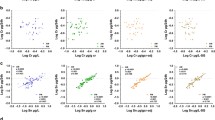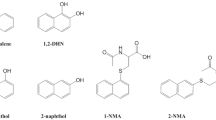Abstract
Purpose
Urinary creatinine is an important parameter for the adjustment of metabolite concentrations in differently diluted urine specimens, as a reference dimension for biological limit or guidance values and as a selection criterion for spot urine samples in human biomonitoring. While the creatinine output of the general population has been well described in environmental surveys, this study focused specifically on creatinine concentrations in a large industrial workforce in order to compare these data with the general population and to provide a database for the calculation of a reasonable conversion factor between volume-related and creatinine-adjusted data and vice versa.
Methods
Urinary creatinine was analysed in 6,438 spot urine samples by a photometric assay in the time period between 1989 and 2009. Basic demographic data (age, sex, body weight, body height) and job category (apprentices, skilled craftsmen, skilled chemical workers, foremen, laboratory staff and executives) were considered in a statistical analysis.
Results
The median concentration of urinary creatinine in all urine samples was 1.36 g/L with male employees showing significantly higher values (1.37 g/L, n = 6,148 samples) than female employees (1.00 g/L, n = 290) and concentrations ranging from 0.01 up to 9.76 g/L. Age, body mass index and job category were significant influence factors on urinary creatinine. About 92 % of all samples showed creatinine concentrations between 0.3 and 3.0 g/L, a range recommended by the World Health Organization as a criterion for valid spot urine samples.
Discussion
The results of this study correspond well with data from environmental surveys and with recent data from an active workforce in industry with similar sampling strategies. Therefore, a median of 1.4 g creatinine per litre urine seems to be a reasonable value for general calculations and adjustments. The study data also support the validity of the current recommendations by the WHO and several scientific committees and institutions with respect to creatinine limits in spot urine samples for occupational-medical biomonitoring.

Similar content being viewed by others
References
Alessio L, Berlin A, Dell’Orto A, Toffoletto F, Ghezzi I (1985) Reliability of urinary creatinine as a parameter used to adjust values of urinary biological indicators. Int Arch Occup Environ Health 55:99–106
American Conference of Governmental Industrial Hygienists (ACGIH) (2009a) Introduction to the BEIs. Documentation of the biological exposure indices. Signature, Cincinnati
American Conference of Governmental Industrial Hygienists (ACGIH) (2009b) TLVs and BEIs. Signature, Cincinnati, ISBN: 978-1-882417-79-7
Bader M, Will W, Tsikas D, Göen TH (2010) Results and implications of an interlaboratory comparison of four analytical methods for the determination of urinary creatinine. In: 8th international symposium on biological monitoring (ISBM), 06th–08th September 2010, Espoo, Finland
Barr DB, Wilder LC, Caudill SP, Gonzalez AJ, Needham LL, Pirkle JL (2005) Urinary creatinine concentrations in the US population: implications for urinary biologic monitoring measurements. Environ Health Perspect 11:192–200
Bolt H (2009) Addendum zu Quecksilber und seine anorganischen Verbindungen. In: Drexler H (ed) Arbeitsmedizinisch-toxikologische Begründungen. Biologische Arbeitsstoff-Toleranzwerte (BAT), Expositionsäquivalente für krebserzeugende Arbeitsstoffe (EKA) und Biologische Leitwerte (BLW). Deutsche Forschungsgemeinschaft, 16. Lfg., Wiley-VCH, Weinheim
Cockcroft DW, Gault MH (1976) Prediction of creatinine clearance from serum creatinine. Nephron 16:31–41
Cocker J, Mason HJ, Warren ND, Cotton RJ (2011) Creatinine adjustment of biological monitoring results. Occup Med 61:349–353
Deutsche Forschungsgemeinschaft (DFG) (German Research Foundation) (2010) List of MAK and BAT values 2010. Senate Commission for the Investigation of Health Hazards in the Work Area. Report no. 46, Wiley-VCH, Weinheim
Gaines LGT, Fent KW, Flack SL, Thomasen JM, Ball LM, Zhou H, Whittaker SG, Nylander-French LA (2010) Effect of creatinine and specific gravity normalization on urinary biomarker 1,6-hexamethylene diamine. J Environ Monit 12:591–599
Kawai T, Eitaki Y, Ukai H, Inoue O, Maeshima Y, Ueda N, Ohashi F, Sakurai H, Ikeda M (2010) Validation of urine density correction in cases of hippuric acid and un-metabolized toluene in urine of workers exposed to toluene. Ind Health 48:154–163
Tsikas D, Wolf A, Mitschke A, Gutzki FM, Will W, Bader M (2010) GC–MS determination of creatinine in human biological fluids as pentafluorobenzyl derivative in clinical studies and biomonitoring: interlaboratory comparison in urine with Jaffé, HPLC and enzymatic assays. J Chrom B 878:2582–2592
Umweltbundesamt (UBA) (German Federal Environment Agency) (2002) Umwelt-survey 1998, band III: human-biomonitoring. Stoffgehalte in Blut und Urin der Bevölkerung in Deutschland. WaBoLu-Hefte 1/02
Umweltbundesamt (UBA) (German Federal Environment Agency) (2005) Normierung von Stoffgehalten im Urin–Kreatinin, vol 5. Stellungnahme der Kommission Human-Biomonitoring des Umweltbundesamtes, Bundesgesundheitsbl Gesundheitsforsch Gesundheitsschutz, pp 616–618
Weihrauch M, Schulze B, Schaller KH (2000) Creatinine as a reference parameter for the concentration of substances in urine. In: Greim H, Lehnert G (eds) Biological exposure values for occupational toxicants and carcinogens. Critical data evaluation for BAT and EKA values. Deutsche Forschungsgemeinschaft, vol 3. Wiley-VCH, Weinheim, pp 35–44
World Health Organization (1996) Biological monitoring of chemical exposure in the workplace, vol 1. World Health Organization, Geneva
Acknowledgments
The authors thank Dr. Mei Yong and Mr Michael Schuster, Competence Center Epidemiology, Occupational Medicine & Health Protection, BASF SE, Ludwigshafen, for their support and Mr. Friedhelm Eberle, formerly Clinical Laboratory, Occupational Medicine and Health Protection, BASF SE, Ludwigshafen, for urinary creatinine determinations.
Conflict of interest
The authors declare that they have no conflict of interest.
Author information
Authors and Affiliations
Corresponding author
Rights and permissions
About this article
Cite this article
Bader, M., Messerer, P. & Will, W. Urinary creatinine concentrations in an industrial workforce and comparison with reference values of the general population. Int Arch Occup Environ Health 86, 673–680 (2013). https://doi.org/10.1007/s00420-012-0802-4
Received:
Accepted:
Published:
Issue Date:
DOI: https://doi.org/10.1007/s00420-012-0802-4




